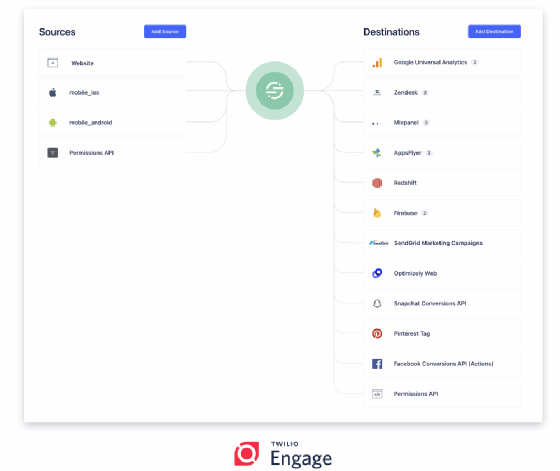
Getty Images/iStockphoto
Twilio delivers API-driven customer engagement platform
Twilio's new customer engagement platform merges Flex customer service and messaging with the Segment customer data platform.
Developers who use Twilio for messaging, customer data management and communications got their first glimpse of the Twilio Engage customer engagement platform, which routes customer data through marketing and customer service channels.
Almost two years in the making and previously touted as a marketing automation platform, Engage arose from Twilio's late-2020 acquisition of Segment for $3.2 billion.
Some 60% of marketers prefer an integrated CX application suite provided through vendors such as Salesforce, according to a Gartner survey of 405 marketers earlier this year. Twilio leans toward the other 40%, who want to build custom tools with the messaging APIs that push communications through popular apps and want to try emerging channels as well.
Segment built a developer-friendly platform, a trait that initially drew Twilio's attention and drove the eventual acquisition. Twilio customers want to customize experiences in ways that less developer-friendly platforms can't, said Kathryn Murphy, Twilio vice president of product, data and growth.
While composable and headless might not be in the average marketer's vocabulary, that's what a lot of them are looking for.
"They don't quite use those words yet, [but] that's kind of what they're describing," Murphy said. "For example, a marketer would say things like, 'Well, I need to have customer reengagement journeys that cross channels and paid media' -- these are the words they would use. They would never say, 'What I need is headless, or an open system that allows me to connect all these other systems and channels together.'"
Customer data becomes golden
Companies that look to build experiences as products might find that approach more difficult to execute in the integrated stack, said Ben Bloom, vice president analyst at Gartner, because journey orchestration can often pose thorny technical problems. Those customers who need more flexibility to build their digital experiences might see Engage as a potential fit.
"As it becomes harder and harder to persuade customers to part with their precious first-party customer data, I think it's very reasonable that organizations might seek to build more product-type experiences, rather than just publishing content," Bloom said. "Potentially, that would lean into the idea that you need something that's more developer-focused as part of your marketing technology stack."

CDPs, mainly the purview of marketers in the last decade, have expanded into other realms of customer experience, such as the contact center. Salesforce, with the September preview of Genie, devoted much of its Dreamforce hype this year to the generalization of its CDP across marketing, customer service, sales, e-commerce, and even Tableau and MuleSoft.
Twilio's tools will instantly appeal to prospective customers on the retail side, as well as existing customers who use many different messaging channels and, by extension, Twilio APIs to drive that messaging, said Daniel Newman, founding partner and principal analyst at Futurum Research. As more companies realize the power of connecting all their data, their product vendors will have to compete on data handling and integrations with cloud providers.
"A company's data -- ERP data, supply chain data, human capital, your resource data, project management data -- is all interdependent," Newman said. "Data, as an enterprise advantage, continues to zoom out. Salesforce is now doing it holistically at a customer level. And you can zoom out even further with the Oracles and SAPs doing that at an enterprise level. And I don't see that changing."
Twilio Flex users get Google integration
Users of Twilio Flex and Voice, the company's open contact center platform tools, can now more easily integrate chatbots and interactive voice response (IVR) tools with Google AI. The company released a Twilio Voice and Google Dialogflow CX integration into public beta, which can automate IVRs.
Twilio Flex users can also integrate Google Contact Center AI and Dialogflow CX with a new connector through Twilio partner Sabio that enables both virtual agents and live agent assist tools. The present economic climate, including a potential recession, drives the need for automation and self-service, said Simonetta Turek, general manager of Twilio Flex.
"The economic situation is putting a lot more focus on efficiency and effectiveness -- traditional focus areas for the contact center, [but even more so] for Flex customers in particular because so much of the customer journey [is] beyond post-sale support," Turek said. "They serve the sales cycle as well ... [and] that infusion of data personalization and intelligence is super important."
Twilio Engage and Flex updates were released in conjunction with Signal, Twilio's annual user and developer conference this week.
Don Fluckinger covers enterprise content management, CRM, marketing automation, e-commerce, customer service and enabling technologies for TechTarget.








